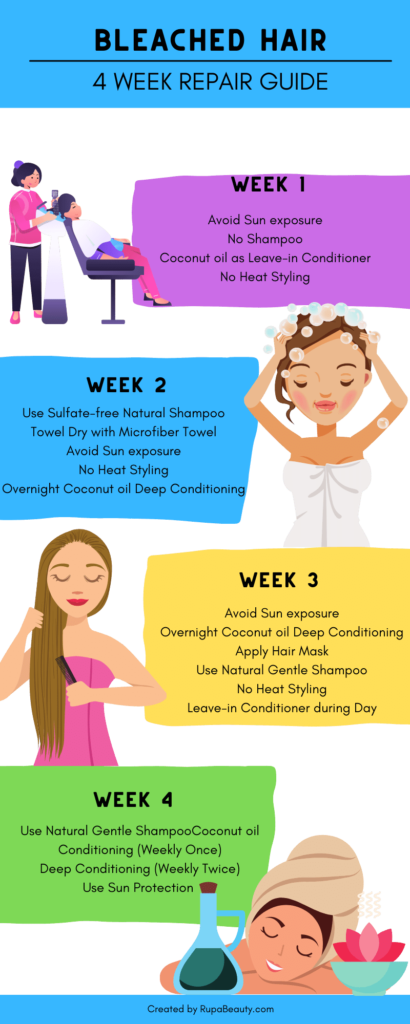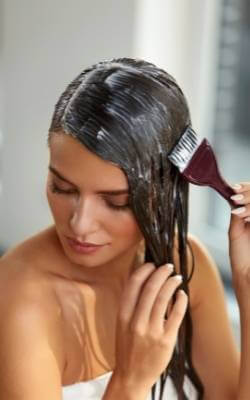Dryness, frizz, and breakage are just a few of the potential adverse effects of bleaching your hair. This article will provide you with advice on how to recover and what to do right after bleaching hair.
Table of Contents
What happens to your hair after bleach?
Most hair lightening products involve some level of bleach, whether you’re colouring your hair at yourself or with the help of a hairdresser. Bleach is still one of the easiest and fastest ways to remove the color from your hair strands, and for good reason.
Changing your hair colour using bleach, on the other hand, isn’t free. Bleach is a harsh intruder that tears down the proteins in your hair to erase the colour. Your hair strands will be lighter and weaker once the bleach has washed out.
Alkaline compounds, which are lighteners, cause your hair to expand and open the cuticles throughout the bleaching process. The alkaline chemicals reach the hair’s cortex and break down the natural colors known as melanin once the cuticles open. Bleach will break down the natural fatty acids in your hair shafts in order to remove the dark pigments, leaving your hair brittle. The cuticle continues to spread until it is completely open and nothing can hold it together. Split ends occur at the end of the process, revealing the cortex. These damages may cause your hair to seem unhealthy.
While the cuticle should theoretically seal and return to normal, hair bleach has a habit of disturbing those scales, making them unable to lay flat. Because each strand actually takes up more space, bleach-damaged hair generally has a greater volume than virgin hair. As a result, moisture escapes from the hair shaft’s inside. Hair becomes brittle, dry, and prone to breaking. According to a 2011 research, hydrogen peroxide, often known as bleach, is a chemical that increases the stains on our hair while also assisting in the decomposition of the melanin that it naturally contains. The first symptom is swelling, which is why damaged bleached hair seems so full. Furthermore, the lack of melanin causes your hair to seem white and depending on the color of the hair dye, it might take on reddish or yellowish tones. (Source)
What to do right after bleaching hair
It’s time to take care of your severely damaged, dehydrated, and fatigued hair now that you’ve adequately prepared for bleaching and have completed the procedure. Even well-done bleaching with high-quality products is stressful and harmful to the hair, so you’ll need to take extra precautions. Following are some suggestions on what to do after you’ve bleached your hair:

No Shampoo for 2 days
Bleaching the hair removes the natural colors while also breaking disulfide bonds, cyst bonds, and hydrogen bonds, i.e. the complete hair structure.
After bleaching your hair, you should wait 48 to 72 hours before washing it. Your hair will restore its natural moisture in this manner. The oils produced by your hair are required to heal the damage caused by the bleaching. Washing with shampoo will wash these beneficial oils.
All of your bleaching and hair-care efforts will be for nothing if you don’t wait at least 48 hours. Your bleached hair will become drier, dry, and frizzy as a result of the bleaching process.
Use sulphate and paraben-free products 48 hours after bleaching your hair. Also, for the first and future washes, reduce the water temperature and use hydrating hair products.
Avoid Sun exposure
After the bleaching procedure, stay out of direct sunlight. Although the sun provides you with your daily dose of Vitamin D, too much of it can harm your hair and cause breakage. Sunblock may be used to protect your hair in the same way it protects your skin. Sunblock may also be put on your hair to protect it from the sun’s UV radiation.
Don’t tie hair too tight
Avoid tying your hair in stressful or complex styles after the bleaching procedure. Wearing your hair in a tight bun all day might put undue stress on your roots. This adds stress to your hair and as a result, causes further hair breakage and may get damaged. If you don’t want your hair in your face but still want to knot it, a hairband will suffice. It’ll accomplish the same goal and won’t do as much damage to your hair as tying it firmly would.
No Heat Styling
Straighteners, tongs, and hair dryers may dry out hair, which can lead to damage if it’s bleached. Heat can also diminish the color and sheen.
Heat styling tools should be avoided at all costs. Heat styling can dehydrate hair strands. At this time, your straw-like hair is attempting to retain as much moisture as possible in the strands.
Start the Repairing Process

Dryness, frizz, and breakage are just a few of the possible adverse effects of bleaching your hair. The hair cuticle, which holds in moisture, has been disturbed, which is why bleached hair looks “frizzy” or “fried.”
Fatty acids and numerous essential hair proteins are found in hair. Bleaching affects not just melanin and the cuticle structure of the hair, but also the fatty acids and other essential hair proteins, giving the hair a straw-like appearance.
You can use additional products to coat your hair and assist restore gloss and shine while your hair cuticle heals.
Stick to hair healing and moisturizing treatments, such as oils, that you may already have on hand. Olive and coconut oils may help your locks shine and hydrate and they’re a simple and inexpensive approach to speed up the healing process. Almond oil is high in proteins and vitamin E, which work as deep conditioning therapy and aid in hair cuticle repair.
Coconut oil is one of the few oils that has been proved to enter strands and repair dry, damaged hair. Use only extra virgin, cold-pressed, unrefined coconut oil to get the most out of the oil and keep the naturally existing phytonutrients intact. It has a higher lauric acid (fatty acid) concentration than other kinds of coconut oil.
Apply Hair Conditioner
Washing your hair less frequently does not imply that you should abandon your hair care routine completely. Because bleaching your strands causes them to become extremely dry, it’s critical to replace your shampoo with a deep conditioner and moisturising conditioner. This helps to restore strength and lustre to your hair by filling up the excess porosity.
You should also use leave-in conditioners. These may be found in nearly any supermarket and can help to restore bleached hair. You may apply certain leave-in conditioners in the shower since they are thick. Others are simple spray-on solutions that you may apply to your hair before leaving the house.
Pay attention to the recommendations on the label, and search for products that claim to have hydrating and keratin-building properties.
Apply Hair Mask

A hair mask is a thorough conditioning treatment for the hair. It has a higher concentration of nourishing elements than your regular hair conditioner. Hair masks are intended to infuse the hair shaft with much-needed nutrients, leaving your hair strong, silky, and glossy. They are tailored for different hair types.
Hair masks with moisturising substances such as egg white, honey, and avocado can help your hair regain its softness and elasticity after a hair bleaching treatment. Hair masks made using common household items can be used two or three times each week until your hair’s condition improves.
There are lots of ready-made alternatives to select from if you don’t have time to prepare a DIY hair mask or don’t want to mess with measuring and mixing the components. Hair masks are available online, at drugstores, and in beauty supply stores.
If you buy a ready-made hair mask, seek natural components like plant extracts, butter, and oils that are free of preservatives and chemicals.
Ditch your Cotton Towel
If done frequently, drying the moisture out of the hair with a cotton towel causes severe damage. The hair cuticles and roots can be severely damaged. Hair becomes brittle as a result of exposure to it. The texture and softness of microfiber towels are unparalleled. They’re also thick at the same time. As a result, even if you use these towels a lot, they will not harm you.
Microfiber towels should be used instead of cotton towels since they help to minimise breaking in bleached hair, which is crucial.
Microfiber towels are considerably gentler on your hair strands, allowing your hair’s cuticles to stay lovely and smooth, resulting in less frizz.
Ditch your Cotton Pillow Case
It’s critical to safeguard your brittle, dry strands as you sleep. Cotton pillows are significantly harsher on hair than silk pillowcases. Hair clings to cotton fabric, whereas it slides over silk due to the nature of the fabric, protecting your hair follicles from additional harm. Using a cotton pillowcase causes friction, which leads to breaking. Cotton also absorbs moisture from your hair, making it drier.
Brittle hair can also be helped by using a silk pillowcase. Because cotton is more porous than silk, conventional pillowcases absorb moisture from your hair, but silk retains it. A silk pillowcase will be a blessing if you suffer from dry strands or a flaky scalp.
Long Term Tips for maintaining bleached hair
Use a combination of Cold and Hot Water
Cold water: When washing out the conditioner in your hair at the end of the washing session, use cold water. This is due to the fact that cold water seals the cuticles and pores in the scalp, adding lustre and shine as a result of the closed cuticles. It actually aids in locking in the moisture of the hair as well as clumping the curls and coils together. Warm water, on the other hand, causes frizz, whilst cold water helps to flatten the hair.
Warm water: When cleansing your hair at the start of the wash day, use warm water. Warm water opens the cuticles of the hair and the pores on the scalp, allowing debris, buildup and residue to be removed from the scalp and hair. This is identical to washing your face with warm water, in that the warm water opens up the pores, allowing any oil or debris to be removed. Warm water, on the other hand, has the disadvantage of causing frizz and drying the hair, therefore it should only be used to cleanse the hair.
Now you know how different water temperatures impact our hair and how to plan your wash day to get the ideal, gorgeous result!
Drink more water for hair health
Water is essential for natural hair development. Our hair shaft is made up of more than 25 percent of water, much like our body, which has high water content. Water, as a result, promotes hair growth.
Water replenishes the human body and supports a variety of important physical processes, and it also promotes hair follicles by assisting vitamin and mineral absorption.
Water aids in the removal of poisons from the body. This not only aids in the proper functioning of the human body, but it also aids in the growth and maintenance of hair. Toxins stifle hair development and can cause a slew of biological issues.
Water seeps into the hair, giving it a fuller appearance. On the other hand, dry hair shrinks back down. Hair damage is more likely as a result of this. Hair should be washed with oil and water on a regular basis to help it maintain moisture and nutrients.
In order to avoid hair damage, proper diet and hydration are also required. Fruits and vegetables with high water content should be consumed in large quantities. Coconut water and fruit juices supply not only the required fluids but also a number of important minerals and vitamins.
Your hair will stay moisturised if you drink enough water. As a result, hair loss, hair fall, dry hair, brittle hair, and itching may all be avoided.
Having the right quantity of water in your diet keeps your scalp moisturised and healthy. Insufficient water intake not only dries out your scalp, but also slows down hair development, leaving your hair dry and straw-like. Split ends and breaking are common in dry hair strands when combing.
Summary
Hair strands might be damaged by bleach, but there are natural solutions you can attempt to restore their strength and elasticity. The true treatment may be a little patience, since your hair may take some time to restore its form.
Stick to a regular hair hygiene practice that restricts heat styling and includes a moisturizer and sunscreen to get the most out of your bleached hair.
If your hair does not begin to restore its shape and stability within a month to six weeks, you may need to seek expert assistance.
FAQ
How frequently should I bleach?
You should at least give 2 months gap between your bleaching sessions. As per the American Academy of Dermatologists, you should give at least 8 to 10 weeks gap between your bleaching sessions to maintain hair health. (Source)
What Type of Coconut Oil is Right for my bleached Hair?
Unrefined or virgin coconut oil is always preferable to processed coconut oil. This is due to the fact that virgin coconut oil is produced using a cold-process technique, which preserves all of the nutrients. Additional processing may result in nutritional loss.
Coconut oil contains lauric acid triglyceride with a low molecular weight. As a consequence, it gets absorbed by the hair shafts quickly and preserves the hair protein. Virgin coconut oil is said to preserve all of the oil’s benefits.
You can further resist the bleach-related damages by preparing a pre-wash hair mask with virgin coconut oil. This process lets your hair absorb even more moisture and helps in maintaining your bleached hair healthy and smooth. This also helps your hair to retain moisture and decrease dryness.
Does Bleach cause permanent damage to hair?
Dying and bleaching your hair permanently affects its integrity. After all, you’re changing its makeup with strong chemicals, and there’s no magic reversal wand you can wave to erase it. However, if you get your hair colored by an expert hair colorist who knows how to treat and dye hair, the damage should be minor.
The texture of the hair is permanently altered when it is lightened. However, how severe that change is will be determined by how well your hairdresser understands how to care for colored hair.
Color damage is an unavoidable side effect of hair dyeing, but it may be avoided by utilizing the correct procedures.
Is it better for your hair to be clean or dirty when bleaching?
Begin the procedure with unclean, greasy hair if at all feasible. Washing your hair before bleaching it, whether the night before or two days before, removes the hair of its natural oils. Since these natural hair oils protect the hair shaft throughout the harmful bleaching process, it is critical not to wash them away hours before you coat your hair with chemicals.
If you’ve already had your hair dyed or chemically treated, use a deep conditioner about a week before your visit.
If you really have to wash your hair the night before, soak it in coconut oil after washing and leave it in overnight to help reduce any damage caused by the bleaching process.
You should not wash your hair on the day of the appointment. It’s really better for your hair to be a bit greasy and unclean when you bleach it. Do not wash your hair for at least two days before bleaching.
Unlike certain hair colors, bleach does not need to be applied to clean hair. Having unclean hair will not prevent the bleach from dispersing evenly.

Creative, versatile, and passionate about her craft, Rupa Das is a well-recognized name in the world of fashion and makeup! This is a woman who has been in the fashion and makeup industry for 24 years and is still one of the leading international makeup artist in the circuit! She has worked in big brands like Lakme, Green Trends, Colors and transitioned to become a Beauty (Hair & Skin) Trainer.